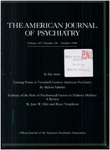Idiopathic basal ganglia calcification and organic mood disorder
Abstract
Idiopathic basal ganglia calcification is a syndrome consisting of bilateral basal ganglia calcifications, neuropsychiatric abnormalities, disturbances of movement, and normal calcium and phosphorus metabolism. The best described neuropsychiatric alterations are dementia and an organic psychosis. Organic mood disorder has been reported less often, and mania secondary to idiopathic basal ganglia calcification has not been noted previously. The authors describe five patients with idiopathic basal ganglia calcification and organic mood changes, including one patient with secondary mania. Symptoms of idiopathic basal ganglia calcification resemble those of other disorders affecting subcortical structures and support an association between mood, affect, cognition, and the extrapyramidal nuclear system. Treatment may ameliorate the mood disorder.
Access content
To read the fulltext, please use one of the options below to sign in or purchase access.- Personal login
- Institutional Login
- Sign in via OpenAthens
- Register for access
-
Please login/register if you wish to pair your device and check access availability.
Not a subscriber?
PsychiatryOnline subscription options offer access to the DSM-5 library, books, journals, CME, and patient resources. This all-in-one virtual library provides psychiatrists and mental health professionals with key resources for diagnosis, treatment, research, and professional development.
Need more help? PsychiatryOnline Customer Service may be reached by emailing [email protected] or by calling 800-368-5777 (in the U.S.) or 703-907-7322 (outside the U.S.).



